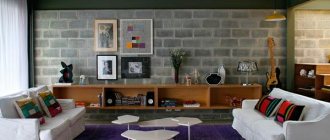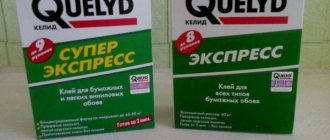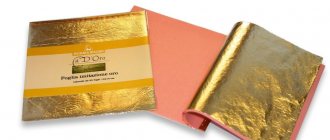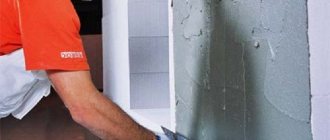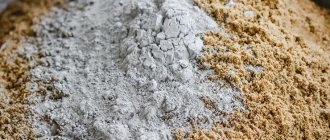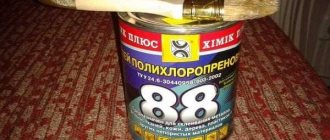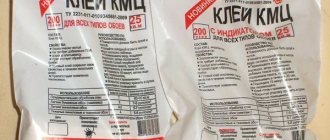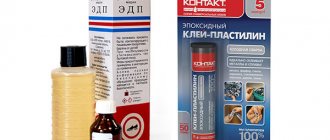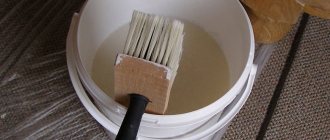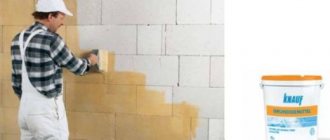Glue for gas silicate blocks is produced by combining cement, sand, plasticizers and modifiers. The advantage is due to the thin-layer application of the product (1-5 mm), as well as the preservation of the adhesion strength of the parts with a minimal “cold bridge”.
The instructions for preparing the mixture must be followed, and the gas blocks themselves must be smooth, without cracks. Only with the correct application of the adhesive can you count on maximum thermal insulation and surface resistance to low temperatures.
What time of year do you lay blocks?
Winter summer Spring Autumn
Construction with gas silicate (aerated concrete) after the onset of cold weather or frosts is carried out using frost-resistant glue with additives. The material itself is also used for working with foam concrete slabs, bricks, and ceramic blocks.
Composition and properties of glue
The assembly adhesive contains:
- Portland cement (high-quality), which serves as a binding base;
- sand (exclusively fine-grained composition);
- polymers, modifying additives.
Additional components contribute to the plasticity of the finished solution and increase its adhesive properties. Modifying additives are needed to preserve internal moisture, which protects the dried solution from cracking and crumbling. Filling voids and seams reduces the degree of thermal conductivity of the entire structure.
Regular glue in sub-zero temperatures
An adhesive mixture, the composition of which does not include the necessary anti-freeze components, cannot be used for construction work when the thermometer is below zero!
Conventional glue will practically not harden, and will not gain even the minimum strength sufficient to fix aerated concrete blocks. Further operation of such a building will be short-lived and even dangerous for human life.
Glue selection criteria
The selection of glue for laying blocks should be based on the following criteria:
- recognition and characteristics of the manufacturer, which controls the quality of its products;
- compliance with the requirements for packaging and storage of the composition (dry, ventilated room without serious changes in temperature and humidity).
It is not recommended to purchase glue by weight; it is better to choose manufacturers who produce other building materials.
It is important to pay attention to the shelf life of the composition, as well as the presence of the necessary properties, for example, frost resistance. You should consider in advance the amount of mixture for the planned work. To do this, you need to know the optimal thickness of the mortar applied between the blocks, for example, for 1 m3 of masonry with a thickness of 3 mm you will need at least 8-9 kg of the mixture.
Thick-layer adhesive mixtures
A package (25 kg) of summer (basic) thick-layer adhesive mixture ArteMix today costs about 190 rubles. The solution prepared from it allows you to create a masonry joint between aerated concrete blocks from 3 to 15 mm. Of the undoubted advantages of this composition, it should be noted a very high frost resistance class - F100. This figure is the maximum for products of a similar purpose. Naturally, the consumption will directly depend on the thickness of the seam, and according to the manufacturer, it averages from 2 to 4 kg per 1 m². The declared “viability” of the finished solution is at least 2 hours. The maximum size of fillers used is 0.8 mm.
But the more expensive (the cost of a 25 kg bag is about 270 rubles) summer Ceresit CT 21 (from the German manufacturer Henkel) is inferior to the Russian ArteMix both in permissible seam thickness (from 2 to 10 mm) and in frost resistance (F75). However, it surpasses it in compressive strength - 7.0 MPa (the Russian competitor has 5.0 MPa). The time for adjusting the laid block is about 10 minutes. Ceresit CT 21 (winter) will cost the consumer a little more - about 300 rubles (per bag).
On a note! Due to the fact that increasingly high demands are placed on modern building materials, manufacturers of aerated concrete blocks are trying to produce products with the smallest deviations from the declared geometric dimensions of the products. Therefore, thick-layer adhesive mixtures intended for adjusting the horizontal level of blocks are not so in demand and are not represented on the modern construction market in a very wide range (unlike thin-layer SCS).
Advantages and disadvantages
Plasticity and economy are not the only advantages that adhesive for aerated concrete blocks has. The list of advantages of the building material also includes:
- increased degree of adhesion (adhesion) of parts;
- lack of vulnerability to moisture and temperature changes;
- optimal speed of grip of parts;
- no risk of shrinkage;
- you can make thin layers of glue by using fractionated sand and Portland cement;
- moisture-retaining components are able to protect the surface from the formation of mold between the blocks and on their surface, which significantly increases the service life of the object itself;
- the possibility of additional strengthening of the structure itself while maintaining its solidity;
- increased heat-insulating properties of the surface, thanks to the leveling of “cold bridges”.
A dry adhesive composition is more expensive than a standard sand-cement mortar, but practical consumption using a minimum layer thickness and increased heat-insulating properties is more economical and more profitable in terms of results.
When choosing adhesive compositions, you can count on the most even, beautiful result. This saves effort and time on surface treatment before finishing.
Among the nuances of use, the requirement for smooth surfaces stands out. The price is offset by the economical consumption, since the solution itself is needed 4-5 times less than traditional cement with sand.
The main advantages of glue over mortar
To ensure durability and high-quality adhesion of the blocks, it is recommended to use a special adhesive composition. The use of the classic version with cement-sand mortar entails a number of problems that can arise both during construction and during the operation of the building:
- the appearance of holes and cracks, loose joining of blocks;
- peeling of blocks after the solution hardens, resulting in loss of strength.
In addition to these nuances, difficulties arise with preparing the composition: it needs to be applied in a much larger layer than glue, and accordingly, more time and materials will be required to prepare the composition.
Compared to the classic mixture, special gas silicate glue has a number of advantages:
- Small expense. The technology for working with such glue involves applying it in a very thin layer.
- Resistant to temperature changes.
- Guaranteed wall protection against heat loss.
- Strength is many times higher than when using a classic mixture
- The special components of the glue ensure its rapid hardening and adhesion of the blocks.
Types of adhesives and nuances of application
The variety of adhesives for aerated concrete is determined by seasonal characteristics (for summer and winter use) and differs in the color of the Portland cement binder. In addition to the dry mixtures used for solutions, there are also adhesive foams in cylinders.
Construction adhesive can be white or gray.
- White, which is suitable for summer or indoor work. The external result allows you to avoid additional finishing.
- Gray (winter glue), which can be used for masonry at temperatures not lower than 10 degrees below zero. In addition to the main binding component, the mixture contains antifreeze additives.
According to professionals, the winter option should be used at temperatures no higher than 5 degrees Celsius and no lower than 15 degrees below zero. It is in this case that the risk of possible errors and cracks in the seams is minimal.
At elevated air temperatures, microcracks can form in the drying solution, which, in turn, reduces the thermal insulation properties of the entire gas silicate masonry.
Winter glue requires storage in dry, heated rooms and a solution preparation procedure with the addition of water at a temperature of at least 20 degrees. The temperature of the solution itself should be at least 10 degrees (plus), and the finished mixture should be used within 30 minutes after preparation. To prevent freezing of moisture and deterioration of the tightness of the seams themselves, the masonry should be covered with a tarpaulin.
The adhesive foam is applied using a gun and is more suitable for porous concrete blocks and small installation volumes.
Kinds
Today, two types have become widespread, differing in seasonal use.
Summer
White adhesive for aerated concrete is similar to autoclaved block material and consists of special Portland cement. This distinctive feature allows you to significantly save on interior finishing work. From summer glue the surface becomes uniform in color, remains light, and there is no need to hide the seam areas.
Winter
This type of glue is called universal. It contains special components that allow the winter solution to be used at low temperatures.
When choosing this composition, take into account the existing limitations.
Popular manufacturers and brands
- Colmix. Produces Stroy Moment SMK-10. Used in winter. Contains antifreeze additives. Consumption of approximately 20 kg of substance per cube of cellular concrete.
- Volma. Produces an adhesive called Blok.
- Henkel. The company produces Ceresit brand mixtures. There are formulations for winter and summer use.
- Craps. Kreps KGB mixture is produced. Can be used in winter, but at temperatures not lower than -10°C. Apply a layer 2 mm thick. After preparing the working solution, it can be used for another 4 hours.
- Aerok. Cellular concrete with glue from this manufacturer can be laid in winter and summer. Operating temperature from -15°C to +35°C. Consumption per cubic meter is approximately 15-18 kg, when applying a 3 mm layer.
Before you find the desired adhesive mixture, you need to understand the characteristics of their composition and operational differences.
| Brand name | Technical description |
| The main component is cement with polymer additives. There is a separate option for summer and winter construction work. The optimal layer thickness is limited to 1-3 mm. After drying, it is not afraid of moisture and severe frosts. |
| Most often used for porous surfaces. Laying should be carried out at a temperature not lower than 5, but not higher than 25 degrees Celsius. The finished object is able to withstand temperature changes in the range from -30 to +70 Celsius. Once prepared, the solution must be used within the first 4 hours. |
| Can be used for both internal and external masonry using grooved and grooveless gas blocks. It is considered a beneficial economical option for thin-seam laying of partitions. Plastic and frost-resistant. |
| It is characterized by a gypsum binding composition and has increased adhesion. Used for leveling surfaces. Environmentally friendly composition. |
| Cement serves as the base, and organic modifiers and fillers allow the use of glue under conditions of thin-layer masonry with maximum thermal insulation. For example, adhesive for aerated concrete blocks Ceresit ST21 is better suited than others for working with cellular concrete. |
| It features an environmentally friendly composition without toxic additives, which is suitable for external and internal work. |
| One of the best solutions when working with porous aerated concrete. Increased adhesion is due to the presence of polymers, and plasticity is due to modifying additives. An important feature is that the position of the blocks can be adjusted after installation within 20-25 minutes. |
| High quality results of winter work at a relatively affordable price. Dried seams remain invulnerable to atmospheric factors, which means there is no risk of cracks appearing in the seams. Easy to apply. |
| The presence of special modifiers in the composition determines the frost resistance of the solution. Can be used for all types of blocks as well as slabs. |
| It is used in thick-layer aerated concrete masonry methods at any operating temperature. Also suitable for leveling walls and for laying ceramic tiles (finishing). |
| It is distinguished by its multicomponent composition, where, in addition to cement and polymers, there is also quartz sand. The identical composition of aerated concrete blocks allows the creation of monolithic reinforced structures. |
| The adhesive solution is used to increase the thermal insulation properties of masonry and protect walls from freezing. Can be used both in winter and summer. It is resistant to moisture and sudden temperature changes, and is plastic. |
Only if you follow the correct storage of the adhesive mixture and the procedure for preparing the solution can you count on a high-quality masonry result. Adhesive foam is used for small-scale repair work.
Which adhesive is best for aerated concrete blocks
The choice of a specific composition should depend on the tasks of the builders: first of all, on the installation conditions. This applies to winter and summer mixtures. However, the winter composition is often preferred, since it crystallizes slowly, provides excellent adhesion and subsequently provides a better level of thermal insulation. Aerated concrete houses are rarely left without additional exterior finishing, so the appearance of the seams does not matter.
When purchasing, you need to pay attention to the recommended seam thickness. Conventionally, adhesives are divided into thin-layer and thick-layer. The first include those brands that can be applied in a layer of no more than 5 millimeters. The recommended seam thickness is 3 millimeters. To work with such a composition, experience is required, in addition, the quality of the blocks themselves will be important. Thick-layer adhesives can be applied in layers up to 10 millimeters, but a thin seam can also be made. These options are more versatile.
Consumption per 1 m3 of aerated concrete
If the packaging indicates that the consumption is more than 30 kg, then the glue is intended for filling cracks and chips. Overspending should not be allowed.
Average consumption
Data calculating consumption should be on the packaging of the product itself, for example, 1.5-1.7 kg of dry composition per square meter, subject to a joint thickness of no more than 1 mm. The indicated figures are relevant only when working with smooth horizontal surfaces.
The average glue consumption per 1 m3 of aerated concrete blocks is 15-30 kg (in practice, the figure can increase to 40-45 kg).
Manufacturers, as a rule, produce packages of the adhesive mixture of 20-30 kg, which is just enough for a cubic meter. masonry You should purchase glue with a reserve of at least 25% of the result of the calculations.
What does consumption depend on?
The list of factors influencing the consumption of finished glue for blocks per 1 m3 of masonry includes:
- the presence of defects and unevenness on the surface of the blocks;
- degree of concentration of the mixture;
- solution temperature;
- application tool used;
- current weather conditions.
It is extremely important to choose adhesive mixtures taking into account their intended purpose, for example, for interior work or for work at sub-zero air temperatures.
The setting process can take from 5 to 30 minutes, and complete drying of the joints lasts at least a day. For the most accurate calculation, it is also important to take into account:
- features of the mixture composition (the higher the concentration of sand or other components, the higher the consumption);
- the chosen installation method (beginners always use more);
- the presence of reinforcing layers, which proportionally increases the required thickness of the adhesive solution.
Purchasing a supply of glue in the amount of about 25-30%, as a rule, helps out, since it eliminates the risk of not finishing the job on time.
Calculation formula
Calculation of the amount of dry matter per 1 cubic meter of masonry of aerated concrete blocks is carried out taking into account the length (l), height (h) of the surface, as well as the thickness of the seam of the proposed adhesive composition (b). The first two indicators are measured in meters, and thickness in millimeters. The calculation of quantity (S) also uses the conventional value of the volume of dry concentrate and is 1.4.
The formula itself looks like this: S={(l+h)/l*h}*b*1.4
Standard packaging of dry composition of 25 kg remains convenient when calculated per 1m3 of masonry. In a practical example, it looks like this: after measuring the parameters of the future wall, 64 m3 of aerated concrete was calculated. If the thickness of the adhesive solution is 3 mm, then the product itself will need 64 bags. If the adhesive seam is reduced by 1 mm, then the glue itself will need 5-5.5 kg less.
Consumption of some brands of glue
- Kreps brand adhesive base is considered profitable and economical, since no more than 25 kg of mixture (one bag) is consumed per unit of calculation. The thickness of the seams should be 2-3 mm. If the glue is used on the surface (by area), then it is enough to prepare 1.6 kg of dry substance per square meter. Even with the thinnest layer, the glue remains resistant to frost and mechanical stress.
- , Insi-Block brand adhesive contains quartz sand, as well as mineral additives that cause increased surface adhesion, its strengthening and protection from loss of internal moisture. The optimal seam thickness is 2-4 mm, which means you need to purchase about 28 kg of dry mixture per 1 cubic meter. blocks (with a smaller layer thickness). Since the products are produced in 25 kg quantities, the purchase should be carried out at the rate of 2 bags per 1 m3. Preparation of the solution involves adding 210 ml of water per 1 kg of mixture. In this case, the solution retains its adhesive properties for 3 hours.
- Real brand is one of the most sought after. The result of the masonry is highly frost-resistant and also waterproof. The optimal thickness of the seam does not exceed 3 mm, so for a cube of masonry you will need to prepare 21-25 kg of adhesive composition.
How to calculate consumption?
The glue consumption depends on the evenness of the surface, weather conditions and the qualifications of the technician. Rakhsod is usually indicated on the packaging; on average, it is 25 kg of dry powder per 1 cubic meter of masonry . This indicator is obtained if you make seams with a thickness of 1-2 mm. If the seam is 3 mm, then the consumption will increase: it will be 1.5 bags. For 1 square meter of masonry it takes 1.5-2 kg of dry glue concentrate.
Important ! To save the solution for laying the aerated block, you need to constantly stir it while working.
Read more about calculating adhesive consumption for aerated concrete masonry here.
Preparation of working solution
Before you start work, you need to study the instructions on the packaging and strictly adhere not only to the ratio of the adhesive composition to the volume of liquid, but also to the appropriate temperature regime.
There are also general requirements for the work:
- a container must be prepared in advance where the solution will be mixed, and a drill with a construction mixer;
- the ratio of dry concentrate to water is usually 1 to 0.22 (about 220 ml of water is needed per 1 kg of powder);
- the water temperature must correspond to the instructions, but not lower than 15-20 degrees;
- the mixed solution must be homogeneous.
To obtain high quality adhesive components, it is recommended to mix everything until smooth, leave the mixture for 10-15 minutes, and then mix thoroughly again with a mixer. The prepared mixture should be used within the next 3-4 hours, unless otherwise indicated in the instructions for use. Water cannot be added to a ready-made solution.
What is
Glue for aerated concrete blocks is produced in the form of a dry powder, packaged in paper bags, usually 25 kg. Each manufacturer indicates how much liquid is required to prepare the solution; it is important to strictly observe the proportions so that when mixing the glue does not lose the necessary qualities. On average, 1 bag contains about 5.5 liters of water.
The glue must be stirred in portions, it hardens quickly Source vanna-prosto.ru
Technology of laying gas silicate blocks
You can reduce the consumption of the adhesive base if you use a notched trowel, a mixing paddle, a rubber mallet and a saw with teeth. A metal brush, a coarse grater, a wall chaser and a square for cutting blocks at right angles will not interfere with your work.
If the blocks have the correct shape, then the masonry technology does not require special skills or preparation.
For the first row, it is recommended to use cement mortar. It hardens longer and there is an opportunity to adjust the row.
When laying the first row, the alignment of future walls is controlled not only in their direction, but also along the horizontal surface. First, the corner blocks are laid out and aligned with the guide corners. Only after this begins the laying of gas silicate blocks between the corners along the selected guide.
To increase the adhesive properties, the surface of the blocks can be slightly moistened, for example, using a spray bottle. The construction of external walls begins with fixing the pegs and pulling the rope, the direction of which is checked by a level. It is important to start laying out the internal walls from the outer (side) side. The adhesive composition lubricates not only the horizontal surface of the blocks, but also the contacting ends. It is not recommended to rub in the exposed glue; it is better to remove it with the flat side of a trowel.
To prevent shrinkage and allow the glue to set well, each subsequent row of blocks should be laid out 1-2 hours after the previous one. To level the laid block, a tool such as a mallet (rubber hammer) can be used. The uniformity of the layout is checked using a level. The blocks should be arranged in a checkerboard pattern. The first cement layer must be at least 10 mm thick.
How long does it take to dry and gain strength?
The time allotted for the glue to set will vary for all compositions. This depends not only on the manufacturer, but also on the presence of special additives in the solution that affect the rate of solidification. For example, summer options set faster than winter ones , since they are designed for use at above-zero temperatures.
Complete drying occurs within 1 day, and the material hardens within 2 hours after application. The glue in the seams gains strength 3 weeks after laying.
Some brands of glue, according to workers' reviews, set so strongly and quickly that it is impossible to separate the blocks from each other after 10-12 hours. This information should be indicated on the packaging, since the technician must have an idea of the time allotted for adjustment.
At what temperature can aerated blocks be laid?
The air temperature must be at least 5 degrees Celsius.
In this case, the blocks used should not be frozen or covered with frost. For construction in “mild” winter conditions, frost-resistant glue must be selected. The instructions, as a rule, indicate the possibility of use down to -5 degrees Celsius.
Laying aerated concrete should be abandoned if the air temperature is below five degrees below zero, or during the last 2-3 days the temperature has been below two degrees above zero. Precipitation (for external walls) is also a contraindication for masonry. You can also cover the walls with roofing felt after the work is completed.
Execution of work
The technology for laying aerated concrete blocks with glue differs significantly from work carried out using a cement-sand based mortar.
The process consists of several stages:
- preparation of block material;
- preparing an adhesive solution;
- applying glue to the block surface;
- laying and leveling the block;
- removing excess glue.
The peculiarity of the masonry is that the block surface must be clean; it is prohibited to apply glue to the material covered with a crust of ice.
Additional moistening of the blocks during laying is not required. An exception may be cases when work is performed on a hot day.
Preparation of glue
Manufacturers indicate the proportional ratio of glue and water on the packaging material. It must be remembered that the masonry mixture for aerated blocks should not contain a lot of water.
A mass of homogeneous consistency is obtained if stirring is performed with special attachments attached to an electric drill. After completing the first batch, you should wait ten to fifteen minutes for the glue to “infuse.” During this time, the additives contained in the glue will completely dissolve. Before use, the glue is mixed again.
The prepared glue can be used within two to four hours. The production time depends on the brand of the composition. If the adhesive mass begins to harden, there is no point in adding water - the solution has lost its qualities.
Application
How to properly place the mass prepared for work?
The glue is applied to the block surface using a spatula with teeth or a carriage intended exclusively for this type of masonry composition.
The positive result of using a special set of tools implies a significant reduction in glue consumption, improved adhesion and a reduction in construction time.
The thickness of the glue layer will depend on the teeth of the spatula.
To prevent the wall from collapsing, a cord should be pulled along the masonry row and the work should be controlled at the building level. You can level the blocks with a rubber hammer so as not to damage the block surface. Excess glue is removed with a trowel after hardening.
